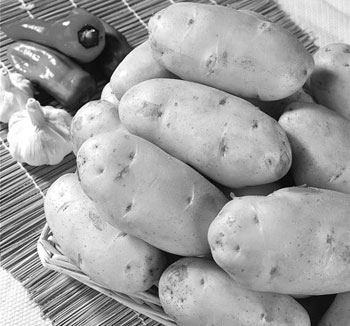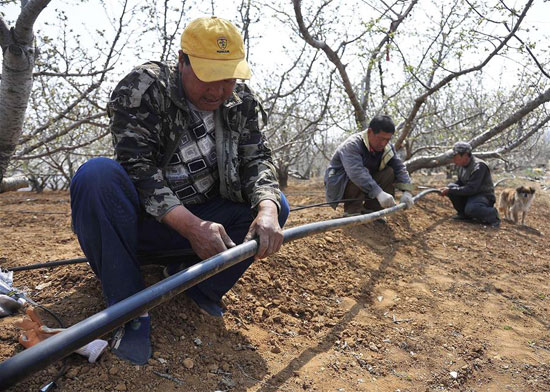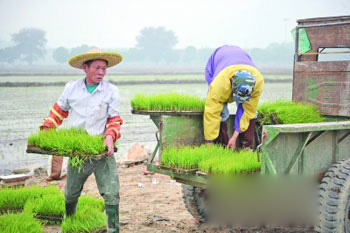Technology of Green and High yield Potato in Dingxi, Gansu Province
Original Title: "Dingxi Model" for Green and High Yield of Potato

Potato (network map)
Anding District, Dingxi City, Gansu Province, is known as the core area of "Chinese Potato Capital" and the reputation of "Hometown of Potato in China." It is the "Demonstration Area for Establishing Famous Brand of National Potato Industry" named by the State Administration of Quality Supervision. In recent years, Anding District has taken potato industry as a strategic leading industry, adhered to the development concept of "ecology, high quality and health," stabilized planting area, expanded improved seed breeding, promoted standardized technology, transformed and expanded storage facilities, strengthened leading enterprises, improved the cultivation market system, made efforts to realize potato production variety specialization, planting scale, production mechanization, management industrialization and staple food of products, and took the lead in realizing full coverage of virus-free seed potatoes in the country. It took the lead in implementing potato insurance and was included in the scope of national policy subsidies, took the lead in tailoring "Golden Potato Treasure" credit products for the development of potato industry, and took the lead in promoting the implementation of potato staple food strategy. "Dingxi potato" has been recognized as a well-known trademark and geographical indication certification trademark in China, and "Dingxi potato virus-free seed potato" has been recognized as a national geographical indication protection product by AQSIQ.
core technology
planting technology
It is advisable to select flat, thick and loose sandy loam and plots without potato or solanaceous crops for rotation. Choose wheat, beans, corn and other crops, avoid continuous cropping, implement potato, wheat, beans 3 or 5 years rotation system, prevent soil-borne diseases and insect pests. At the same time, the paddy, upland, terrace and upland with slope less than 8 degrees with certain scale and area which are beneficial to mechanized operation are selected for planting.
Deep ploughing and soil preparation shall be carried out by tractor supporting dry field ploughshare plough, all-round subsoiler or shovel subsoiler. Deep ploughing 20cm, deep loosening 35cm above, breaking the plough bottom is appropriate, an average of three years deep loosening once. After harvesting the previous crop, deep tillage shall be carried out in time to make the soil stand, dry, mature and accept rainwater. After autumn, shallow tillage shall be carried out to preserve soil moisture. In winter, moderate suppression shall be carried out to protect soil moisture. Before sowing, disc harrow shall be used for harrowing soil preparation, or rotary tiller shall be used for shallow tillage. The depth is generally 10~15cm, so as to make the ground flat, the upper pine loose, the tilled layer soft and the soil pieces fine.
For the plots with serious underground pests, it can be combined with harrowing soil preparation. Generally, 50% phoxim is used per mu, 4~5kg of water is added, and 20~25kg of fine dry soil (sand) is mixed to make toxic soil (sand), or 4~5kg of 3% Lesben granules are evenly scattered on the ground surface, and the soil is ploughed into the soil.
Formulated fertilization adheres to the principle of heavy application of farm manure and coordinated application of nitrogen, phosphorus and potassium, adopts soil testing and formulated fertilization, highlights the promotion of commercial organic fertilizer, continuously reduces the use of chemical fertilizer inputs, improves fertilizer utilization rate, improves crop quality and reduces environmental pollution. According to the soil nutrient supply and N, P and K fertilizer utilization rate in Anding District, 3000kg organic fertilizer was applied per mu in combination with soil preparation, and the formula of 1.7∶1.3∶1.0 was popularized in the north, 1.9∶1.3 ∶ 1.0 in the southeast and 2.0∶1.3∶1.0 in the southwest according to the ratio of N∶ P 2O 5∶ K 2O.
Mulching sowing and mulching: adopting various potato mechanical ridging and mulching planting modes such as black full-film double-ridge side cultivation, black mulch large-ridge side cultivation, semi-film ridging cultivation, drip irrigation cultivation under mulch, etc. Black mulch film with thickness of more than 0.01mm is selected for recycling, so as to avoid pollution to the soil.
Sowing: Sowing can be done when the temperature of 10cm soil layer is stable and passes 7℃~8℃. It usually occurs in late April to early May. When sowing, try to adopt comprehensive mechanized planting mode, which can complete the processes of ridging, fertilizing, sowing, covering soil, cultivating, spraying and harvesting, improve the sowing quality and reduce the labor intensity. The sowing density is 3500~4500 plants/mu, and the requirements are uniform, no replanting, no missing sowing, no damage to seed potatoes, uniform depth, uniform plastic film coverage, consistent ridge height and width, straight sowing rows, consistent row spacing and uniform plant spacing.
Cover soil: generally in the sowing about 10 days after the start of soil, thickness 2~3cm, cover soil to be uniform, scattered, broken.
Chemical weeding in field management: spray BASF Tianpu 200ml mixed with 30kg water on each mu before emergence after covering soil, and carry out closed weeding in soil or spray Dupont Baocheng 6~ 7g mixed with 30kg water on each mu at 2~4 leaf stage, which can effectively control annual grass weeds and some broadleaf weeds.
Intertillage and soil cultivation: two times of intertillage operation is suitable. After emergence, the emergence rate reaches 50%, and the plant height is 5~10cm. The first time of intertillage is carried out when the plant height is 20~25cm. Complete the procedures of loosening soil, weeding, topdressing and cultivating soil between rows, which is beneficial to potato expansion and does not expose stolons.
Pest control: focus on late blight control, use the established potato late blight monitoring and early warning system to accurately predict the occurrence time, occurrence degree and control period of potato late blight, so as to achieve green prevention and control. Generally, from the middle and late July, mancozeb, Dasheng, Kejia, Fushuaide, Baodasen, Jinlei, Kelu and other chemicals are sprayed alternately for control, once every 7~10 days.
Killing seedlings: before harvest, if there are many seedlings and grass, in order to facilitate mechanized harvest, the seedlings can be killed mechanically by the seedling killing machine, generally about 10 days before harvest.
seed potato treatment
Seed potato varieties with high yield, drought resistance and virus elimination within three generations are selected, and special, high quality and strong resistance varieties adapted to ecological conditions of Anding District and market requirements are selected according to market requirements. Kexin No. 1, Jizhangshu No. 8, Atlantic Ocean, Xiabadi, Feiwurita, Longshu No. 10, Longshu No. 7, Longshu No. 6, Qingshu series, etc. are the main varieties planted in the southwest high water and fertilizer area; Longshu No. 10, Longshu No. 7, Longshu No. 6, Zhuangshu No. 3, Jizhangshu No. 8, Qingshu series, etc. are the main varieties in the southeast; Xindaping, Zhuangshu No. 3, Longshu No. 10, Longshu No. 7, etc. are planted in the north.
Seed potato treatment: on the basis of selecting improved varieties, seed potatoes should be healthy, disease-free, non-damaged, smooth skin, bright color, moderate weight of 50~100g, uniform size, good storage characteristics of the variety.
Germination: 10~15 days before sowing, put it indoors at 18~20℃, turn it once every 3~5 days, and cut it into pieces for sowing after about 1cm thick purple buds grow in about 10 days.
Potato cutting: cutting seeds should be carried out 2~3 days before sowing, the size of the cut pieces should be 30~50g, and each cut piece should have at least 1~2 bud eyes. Prepare 2~3 cutting knives, put them into 0.1% potassium permanganate solution or 75% alcohol for soaking and disinfection. Generally, when cutting 30 potatoes, replace the cutting tools once. In the process of cutting seeds, if you encounter disease, rotten seed potatoes should be removed immediately, and at the same time replace the cutter to cut off the way of infection transmission in time. Advocate small whole potato sowing.
Soak seeds with rare earth dry land treasure 100ml mixed with water 5kg, soak for 20 minutes, then take them out and put them in shade to dry for sowing. Or use 12.5 kg of 70% methyl thiophane +2.5 kg of Cobo evenly mixed with 100 kg of talc powder to become powder, mixed with 10000 kg of potato pieces. Or use 24.0 kg of 70% methyl thiophane +1.0 kg of 72% agricultural streptomycin evenly mixed with 100 kg of talcum powder to make powder, mixed with 10000 kg of potato pieces. Or using metalaxyl 25% WP 400 times solution to soak and disinfect seed potatoes can effectively prevent potato blight. Or 1 kg seed potato soaked in 50mL copper sulfate solution with concentration of 2% for 10 minutes can prevent the occurrence of potato ring rot. Or seed dressing with plant ash immediately after sowing, can prevent the occurrence of potato black stem disease.
- Prev

Water-saving drip Irrigation of Orchard in Spring drought in Shandong Province
Water-saving drip Irrigation of Orchard in Spring drought in Shandong Province
- Next

Migrant workers in rice and duck fields in Zhongshan, Guangdong Province can exchange money with each other.
Migrant workers in rice and duck fields in Zhongshan, Guangdong Province can exchange money with each other.
Related
- A course of planting techniques and methods on how to grow carrots
- How to plant the latest tulips?
- Is it better to pick tea in the morning or in the afternoon? When is the best time for tea to be picked? what is the third or fifth tea?
- Launch Yuanxiao Happy combination Haocha + Tea Yuan healthy Taste
- Penghu Tourism "Fireworks 20 Parade with You"
- 2022 West Lake Happiness holds "Digital Revitalization Voucher" and draws iphone13 and laptop.
- Banqiao Fuzhou social houses are designed to change start-up combined with police elimination to create a safe and livable environment
- The convenient measure of "mechanical weeding" in Xinbei has been abused and the Agriculture Bureau has imposed heavy penalties on the illegal land consolidation.
- Changgeng University Joins Hands with Four Memory Factories to Rescue Memory Talent Shortage
- The list of Taiwan's top 100 MVP managers is listed by the Director-General of the Farmers' Association of Sanxia District.

